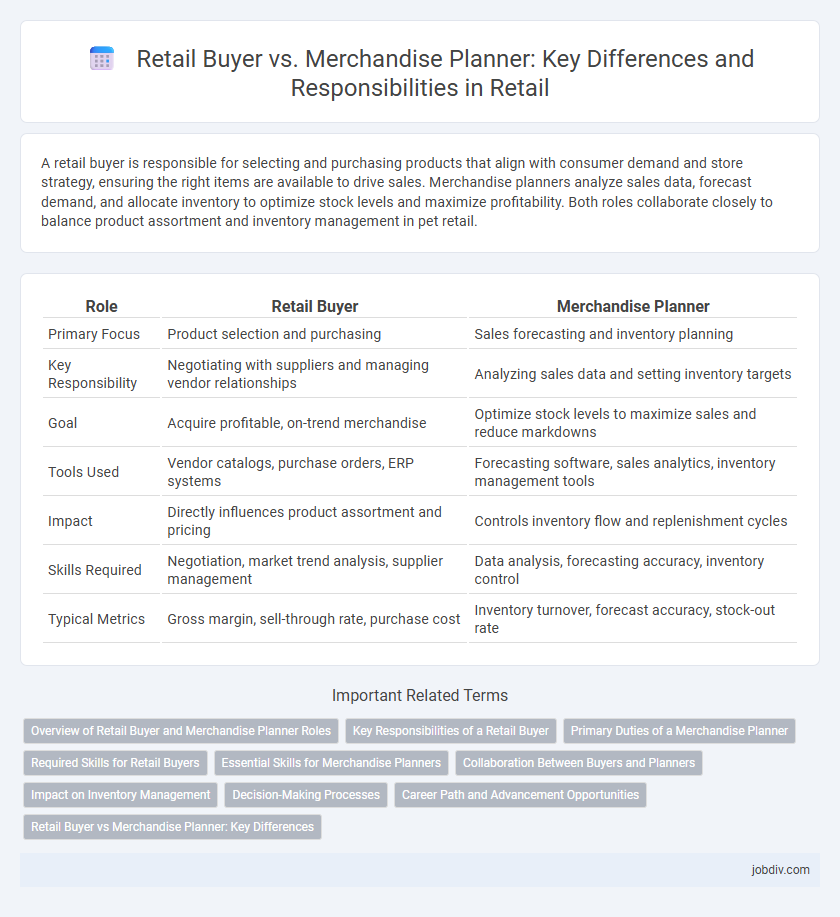A retail buyer is responsible for selecting and purchasing products that align with consumer demand and store strategy, ensuring the right items are available to drive sales. Merchandise planners analyze sales data, forecast demand, and allocate inventory to optimize stock levels and maximize profitability. Both roles collaborate closely to balance product assortment and inventory management in pet retail.
Table of Comparison
| Role | Retail Buyer | Merchandise Planner |
|---|---|---|
| Primary Focus | Product selection and purchasing | Sales forecasting and inventory planning |
| Key Responsibility | Negotiating with suppliers and managing vendor relationships | Analyzing sales data and setting inventory targets |
| Goal | Acquire profitable, on-trend merchandise | Optimize stock levels to maximize sales and reduce markdowns |
| Tools Used | Vendor catalogs, purchase orders, ERP systems | Forecasting software, sales analytics, inventory management tools |
| Impact | Directly influences product assortment and pricing | Controls inventory flow and replenishment cycles |
| Skills Required | Negotiation, market trend analysis, supplier management | Data analysis, forecasting accuracy, inventory control |
| Typical Metrics | Gross margin, sell-through rate, purchase cost | Inventory turnover, forecast accuracy, stock-out rate |
Overview of Retail Buyer and Merchandise Planner Roles
Retail buyers analyze market trends and customer preferences to select and purchase products that meet sales targets and inventory needs. Merchandise planners forecast demand, develop inventory strategies, and allocate stock to optimize sales and profitability across store locations. Both roles collaborate to balance product assortment with financial goals, ensuring effective inventory management and customer satisfaction.
Key Responsibilities of a Retail Buyer
A Retail Buyer is responsible for selecting and purchasing products that meet consumer demand and align with the store's brand and sales objectives. This role involves analyzing market trends, negotiating with suppliers for the best prices, and managing inventory levels to optimize stock turnover. Retail Buyers collaborate closely with merchandise planners to ensure product assortment and pricing strategies drive profitability and customer satisfaction.
Primary Duties of a Merchandise Planner
Merchandise Planners primarily analyze sales trends, forecast demand, and develop inventory plans to maximize product profitability and minimize excess stock. They collaborate closely with retail buyers to align purchasing decisions with sales strategies and financial objectives. Their role involves continuous monitoring of stock levels and adjusting plans to respond to market fluctuations and seasonal changes.
Required Skills for Retail Buyers
Retail buyers require strong negotiation skills, financial acumen, and market trend analysis to select and purchase merchandise that meets customer demand and maximizes profit margins. Proficiency in inventory management, supplier relationship management, and data-driven decision-making is essential for optimizing product assortment and maintaining competitive pricing. Effective communication and adaptability enable retail buyers to collaborate with cross-functional teams and respond quickly to market changes.
Essential Skills for Merchandise Planners
Merchandise planners require strong analytical skills to forecast sales trends accurately and manage inventory levels efficiently, ensuring optimal stock availability. Proficiency in data analysis tools and a deep understanding of consumer behavior are essential for developing effective assortment strategies that align with market demand. Collaboration with buyers and marketing teams enhances decision-making to maximize profitability and minimize markdowns.
Collaboration Between Buyers and Planners
Retail buyers and merchandise planners collaborate closely to optimize inventory management and sales performance by aligning purchasing decisions with forecasted demand and market trends. Buyers focus on selecting products that meet consumer preferences and negotiating with suppliers, while planners analyze sales data, track inventory levels, and develop replenishment strategies. Effective communication between both roles ensures balanced stock levels, minimizes markdowns, and maximizes profitability through data-driven assortment planning and timely order placements.
Impact on Inventory Management
Retail Buyers drive inventory management by selecting and purchasing products aligned with market trends, customer demand, and sales forecasts, ensuring optimal stock levels. Merchandise Planners analyze sales data, inventory turnover, and seasonal trends to develop replenishment schedules and allocation strategies that minimize stockouts and overstocks. Together, these roles enhance inventory accuracy, reduce holding costs, and improve product availability to maximize retail profitability.
Decision-Making Processes
Retail Buyers analyze market trends, customer preferences, and supplier options to make purchasing decisions that maximize sales and profitability. Merchandise Planners use sales data, inventory levels, and forecasting models to allocate budgets and assortments effectively across stores. Both roles require strong analytical skills, but Buyers focus on supplier negotiation and product selection, while Planners specialize in inventory optimization and sales forecasting.
Career Path and Advancement Opportunities
Retail Buyers focus on selecting and purchasing products that align with market demand, often advancing to senior buying positions or category management roles by demonstrating strong negotiation skills and market analysis. Merchandise Planners specialize in inventory control and sales forecasting, progressing to roles such as senior planners or merchandising managers through expertise in data analytics and sales trend evaluation. Both career paths offer advancement opportunities into strategic leadership roles like director of merchandising or supply chain management within retail organizations.
Retail Buyer vs Merchandise Planner: Key Differences
Retail Buyers focus primarily on selecting and purchasing products based on market trends, supplier negotiations, and consumer demand analysis. Merchandise Planners specialize in inventory allocation, sales forecasting, and developing purchasing budgets to maximize profitability and minimize stockouts. The key difference lies in the Retail Buyer's emphasis on product acquisition, while Merchandise Planners concentrate on inventory management and financial planning within the retail supply chain.
Retail Buyer vs Merchandise Planner Infographic

 jobdiv.com
jobdiv.com